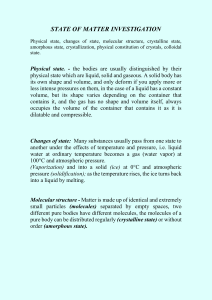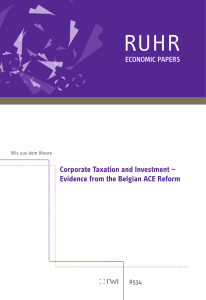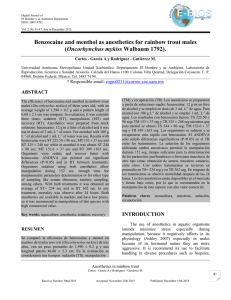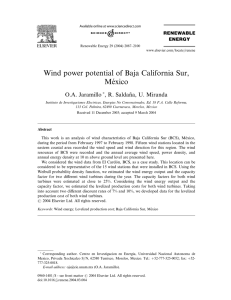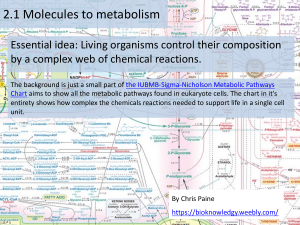Subido por
Roberto García Quintero
Water & Anesthesia: Physicochemical Properties & Physiology
Anuncio
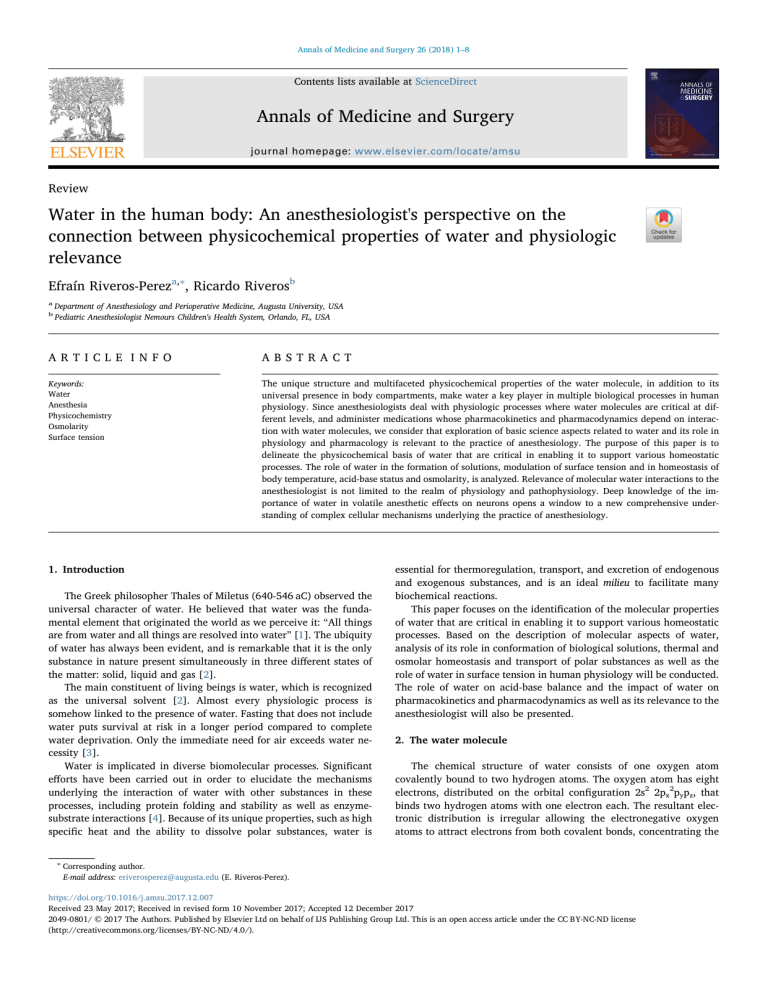
Annals of Medicine and Surgery 26 (2018) 1–8 Contents lists available at ScienceDirect Annals of Medicine and Surgery journal homepage: www.elsevier.com/locate/amsu Review Water in the human body: An anesthesiologist's perspective on the connection between physicochemical properties of water and physiologic relevance T Efraín Riveros-Pereza,∗, Ricardo Riverosb a b Department of Anesthesiology and Perioperative Medicine, Augusta University, USA Pediatric Anesthesiologist Nemours Children's Health System, Orlando, FL, USA A R T I C L E I N F O A B S T R A C T Keywords: Water Anesthesia Physicochemistry Osmolarity Surface tension The unique structure and multifaceted physicochemical properties of the water molecule, in addition to its universal presence in body compartments, make water a key player in multiple biological processes in human physiology. Since anesthesiologists deal with physiologic processes where water molecules are critical at different levels, and administer medications whose pharmacokinetics and pharmacodynamics depend on interaction with water molecules, we consider that exploration of basic science aspects related to water and its role in physiology and pharmacology is relevant to the practice of anesthesiology. The purpose of this paper is to delineate the physicochemical basis of water that are critical in enabling it to support various homeostatic processes. The role of water in the formation of solutions, modulation of surface tension and in homeostasis of body temperature, acid-base status and osmolarity, is analyzed. Relevance of molecular water interactions to the anesthesiologist is not limited to the realm of physiology and pathophysiology. Deep knowledge of the importance of water in volatile anesthetic effects on neurons opens a window to a new comprehensive understanding of complex cellular mechanisms underlying the practice of anesthesiology. 1. Introduction The Greek philosopher Thales of Miletus (640-546 aC) observed the universal character of water. He believed that water was the fundamental element that originated the world as we perceive it: “All things are from water and all things are resolved into water” [1]. The ubiquity of water has always been evident, and is remarkable that it is the only substance in nature present simultaneously in three different states of the matter: solid, liquid and gas [2]. The main constituent of living beings is water, which is recognized as the universal solvent [2]. Almost every physiologic process is somehow linked to the presence of water. Fasting that does not include water puts survival at risk in a longer period compared to complete water deprivation. Only the immediate need for air exceeds water necessity [3]. Water is implicated in diverse biomolecular processes. Significant efforts have been carried out in order to elucidate the mechanisms underlying the interaction of water with other substances in these processes, including protein folding and stability as well as enzymesubstrate interactions [4]. Because of its unique properties, such as high specific heat and the ability to dissolve polar substances, water is ∗ essential for thermoregulation, transport, and excretion of endogenous and exogenous substances, and is an ideal milieu to facilitate many biochemical reactions. This paper focuses on the identification of the molecular properties of water that are critical in enabling it to support various homeostatic processes. Based on the description of molecular aspects of water, analysis of its role in conformation of biological solutions, thermal and osmolar homeostasis and transport of polar substances as well as the role of water in surface tension in human physiology will be conducted. The role of water on acid-base balance and the impact of water on pharmacokinetics and pharmacodynamics as well as its relevance to the anesthesiologist will also be presented. 2. The water molecule The chemical structure of water consists of one oxygen atom covalently bound to two hydrogen atoms. The oxygen atom has eight electrons, distributed on the orbital configuration 2s2 2px2pypz, that binds two hydrogen atoms with one electron each. The resultant electronic distribution is irregular allowing the electronegative oxygen atoms to attract electrons from both covalent bonds, concentrating the Corresponding author. E-mail address: [email protected] (E. Riveros-Perez). https://doi.org/10.1016/j.amsu.2017.12.007 Received 23 May 2017; Received in revised form 10 November 2017; Accepted 12 December 2017 2049-0801/ © 2017 The Authors. Published by Elsevier Ltd on behalf of IJS Publishing Group Ltd. This is an open access article under the CC BY-NC-ND license (http://creativecommons.org/licenses/BY-NC-ND/4.0/). Annals of Medicine and Surgery 26 (2018) 1–8 E. Riveros-Perez, R. Riveros Water as the main solvent in fluid compartments, establishes three types of non-covalent interactions: electrostatic, van der Waals and solvent-induced [10]. These non-covalent interactions rule the conformation of solutions when water is in contact with polar, ionic and hydrophobic solutes. Polar liquids, such as water, are excellent solvents able to participate in solutions by the interaction with other polar substances or ionic materials. Ionic materials dissociate in water, displaying a wide range of physiologic possibilities that range from acid-base homeostasis to transmembrane transport and excretion of substances. When an ionic substance and water are combined in a solution, the electrostatic interactions are reduced in strength in inverse relation to the dielectric constant of water, to the range of other non-covalent interactions [11]. Furthermore, the high dielectric constant of water is critical to avoid formation of strong electrostatic interactions that would render physiologic processes such as signaling and nerve transmission ineffective. Ion-water interactions are involved in biological activities like conformation of proteins, electrostatic potentials, conductances and transmembrane transport [12]. An ionic solute is able to perturb the dynamics of water when participating in solution, while at the same time, this perturbation generates a field that reacts back modulating and altering the solute [13]. This bidirectional effect plays an important role in formation of solutions with hydrophobic substances, through interaction of water with kosmotropes and chaotropes [14]. Kosmotropic cosolvents (Ca2+, Mg2+), when added to water, promote aggregation of hydrophobic solute particles, whereas chaotropic solvents (Cl−, K+, NH4) destabilize such aggregates [15]. The hydrophobic effect, defined as the tendency of non-polar molecules to aggregate and separate themselves from water when found in solution, has biological implications, including formation of cell membranes, protein folding, formation of micelles and adsorption of proteins into lipid layers. Hydrophobic effects are key factors in cell organization and homeostasis that cannot be substituted for by electrostatic or van der Waals forces [11]. A hydrophobic solute alters the structure of water and decreases entropy (degree of thermodynamic disorder of the system) due to stronger bond formation between water molecules around the solute. To minimize the effect of the hydrophobic solutes on water, such solutes aggregate in a smaller surface area inside a “cage” of solvent, maximizing the amount of free hydrogen bonds in water available to interact with other water molecules [16]. Of particular importance is the impact of the hydrophobic effect on protein stability and the effect of ions and salts on protein solubility in water. Protein molecules have their hydrophobic groups in contact with each other and out of contact with water. The force supporting the structure of proteins is not the weak association of their hydrophobe groups, but the repulsion of such groups out of the water medium [17]. Hydration of proteins occur in a ratio of 1.4–4 g of water per gram of protein, so that approximately 80% of body water is bound to macromolecular components [18]. Body compartment formation is the result of the constant interaction of proteins, and ions dissolved in water, separated by membranes by virtue of hydrophobic effects. In 1888, Hofmeister reported that salts affect solubility of proteins in water [12]. This phenomenon has been interpreted as a modulating effect of salts on hydrophobic effects. The physiologic relevance of this physicochemical feature is poorly understood but it might be involved in the effect of different electrolytic solutions used in clinical practice [19]. On the other hand, structured water molecules determine the thermodynamics of binding of ligands to protein receptors, highlighting the central role that water plays in cellular signaling and pharmacodynamics of medications [20]. Finally, van der Waals bonds are forces that keep water together in the liquid state at temperatures below the boiling point. Although the water molecule is electrically neutral, the distribution of charge within the molecule is not symmetrical, creating a dipole moment. This leads to net attraction between poles, creating cohesion [21]. The physiological significance of van der Waals forces is illustrated by their role in Fig. 1. Water molecule: Lobulated orbital configuration. H, hydrogen atom; δ-, negatively charged lobule. δ+, positively charged lobule available to react with negative lobes from other water molecules. highest electronic density (negative charge) around the oxygen atom, and the lowest density (positive charge) close to the hydrogen atoms. The electrical charge of the molecule is neutral with eight electrons forming four pairs of hybrid orbitals. The tetrahedral orbital configuration is stable and facilitates that two orbital lobes establish OeH bonds through shared electrons, while the other two electronegative lobes are available to attract other molecules of water (Fig. 1). The water molecule is asymmetrical and its electrical charge is not evenly distributed (polar structure) [5]. The property of polarity leads to attraction between water molecules through binding of relatively positive hydrogen atoms and the slightly electronegative oxygen atom. The attraction force between water molecules is determined by the high energy contained in the OeH bond of 5.5 Kcal/mol and the Van der Waals interaction [6]. The HeOeH angle is intermediate between a tetrahedral geometry and the angle of a planar pentagon. The average of 104,5° within the molecule (Fig. 2) takes into consideration the distinct geometrical configurations during different modes of vibration, given that the water molecule is not constantly on a zero-point motion situation [7]. The HeOeH angle is a key determinant of polarity that translates into strong interaction between water molecules. Furthermore, this interaction is responsible for the high boiling point and specific heat of water, illustrating the high energy necessary to break HeH bonds. This situation explains the paradox that water is in the liquid state at a wide range of temperatures favorable for physiological processes and not as a gas as would be predicted given its low molecular weight [8]. 3. Role of water in physiologic solutions Human cells are complex systems whose structure and function depend largely on non-covalent interactions not involving creation or rupture of chemical bonds. Protein folding and aggregation, ligandenzyme interactions, transcription and replication of information polymers, transmembrane ion transport, signal transduction and regulation of gene expression are examples of these non-covalent bonds. A characteristic of non-covalent interaction is the moderate energy range of operation, flexible enough to be efficient and to avoid irreversibility of biochemical reactions. In this context, the solvent is not only a diffusion medium but also a mediator of non-covalent interactions [9]. Fig. 2. Tetrahedral angle of water molecule on a zero-motion mode. 2 Annals of Medicine and Surgery 26 (2018) 1–8 E. Riveros-Perez, R. Riveros Electrostatic interactions of water are implicated in the mode of action of different anesthetics [23]. pH is a determinant of the protonation rate that facilitates strengthening of these interactions [24]. It can be speculated that under conditions of plasma acidosis, the protonation rate is accelerated and the electrostatic interactions between volatile anesthetics and target cellular receptors are enhanced. In this context, plasma acidosis increases sensitivity to anesthetics and the dose should be adjusted accordingly. Hydrophobic interactions, on the other hand, are relevant to understand clinical effect and toxicity of local anesthetics. Lidocaine and bupivacaine interact with lipid membranes, increasing its fluidity and binding sodium channels in virtue of exclusion of water molecules. Although the mechanism of action of these two local anesthetic is identical, cardiac toxicity is more pronounced with bupivacaine, apparently due to bupivacaine-selective hydrophobic binding to mitochondrial cardiolipine [25]. This unique mitochondrial effect enhances cardiac toxicity of bupivacaine and toxic doses of this anesthetic are the lowest compared to other medications of the same pharmacological group. In addition to the relevance of water surface tension in human physiology, this property has been used in anesthetic pharmacology. Propofol is the most widely used hypnotic agent in anesthesia. Despite many advantages of propofol as an anesthetic, side effects such as allergic reactions and pain on injection have led the pharmaceutical industry to try to modify its macroemulsion formulation, based on the principles of surface tension and the hydrophobic effect of water [34]. Nanoemulsions are oil-in-water emulsions with droplet diameter ranging between 50 and 1000 nm, made of surfactants that are mixed with water under high shear stress and mechanical extrusion processes [35]. Application of extreme shear is necessary to overcome surface tension energy of water in order to break down droplets into the nanoscale regime [36]. The capacity of nanoemulsions to dissolve large amounts of hydrophobic molecules and the ability to protect medications from hydrolysis makes nanoemulsions ideal to deliver parenteral medications. Based on these principles, propofol has been reformulated as a nanoemulsion to reduce side effects, albeit with changes in pharmacokinetic and pharmacodynamic profiles [37]. Pain on injection is reduced with nanoemulsion preparations of propofol without clinically relevant side effects compared to soy lecithin formulations [38]. This finding illustrates the potential clinical impact of modification of surface tension in anesthetic pharmacology. 4. Surface tension of water and clinical implications 5. Thermoregulation: importance of water Many biological reactions occur at water surfaces and interfaces, and alterations in surface tension underlies many pathological conditions [26]. In addition, surface tension has impact on pharmacologic formulations and technologies [27,28]. The molecules of water experience attractive forces from other neighboring water molecules. In the bulk phase of water, attracting forces in different directions cancel out to a net force of zero; however, water molecules at the surface are subject to forces that tend to pull to the interior of the fluid, creating a linear force called surface tension. Surface tension can be understood as force per unit length or energy per unit area [29]. Human fluids contain different types of surfactants (protein and lipids that get adsorbed at the fluid-gas interface) that affect surface tension of aqueous media. Interfacial forces involved at these complex surfaces are involved in maintenance of cellular architecture and cell-to-cell cohesion [30]. Thermal behavior of water is unique and water constitutes a key component of thermoregulation in humans. Water has high specific heat. The specific heat is the amount of caloric energy per unit mass needed to increase the temperature of a substance by 1 °C. The high specific heat of water (1 Kcal/Kg °C = 4180 J/kg.K), attributed to its capacity to store energy in hydrogen bonds, confers the molecule the ability to buffer temperature changes in the body, as It takes more energy to raise temperature of water compared to the amount of heat to raise temperature of other molecules in body compartments [39]. When a certain amount of caloric energy is applied to water, most of it is spent in breaking hydrogen bonds, leaving only a small portion available to increase kinetic energy of the molecules, a necessary process to increase temperature. Conversely, when the temperature of water drops, hydrogen bonds are restored, releasing a significant amount of energy in the form of heat. Similarly, compared to other substances, water requires significant caloric energy in order to evaporate (latent heat of evaporation of 2270 J/kg.K), meaning that sweating is a very effective mechanism to dissipate heat and lower body temperature [40]. Finally, because of metabolic activity in different organs, particularly in muscle and liver, energy in the form of heat is constantly released and added to aqueous solutions in body compartments. Thermal conductivity of water facilitates both the uniform distribution of generated heat and transport to regions such as skin and respiratory tract, where evaporation takes place [41]. determination of surface tension and cellular adhesion [22]. 3.1. Clinical relevance for the anesthesiologist 4.1. Clinical relevance for the anesthesiologist Particularly relevant to the anesthesiologist is the effect of surface tension reduction of pulmonary surfactant on the alveolar epithelial water interface. Pulmonary surfactant is able to reduce surface tension to impede lung collapse. Pulmonary surfactant is constituted by 90% of lipids and 10% of protein. The main lipid responsible to achieve a surface tension near to zero mN/m during film compression in expiration is dipalmitoylphosphatidylcholine. Hydrophobic surfactant proteins are also responsible for reduction of surface tension due to their hydrophobic properties. The rate of surface adsorption of surfactant generates surface tension of 25 mN/m that matches the cohesive forces on water surface, in order to produce a net surface tension close to zero [30]. On the other hand, although general anesthesia with sevoflurane has been suggested to promote alveolar collapse and hypoxemia, bronchodilation induced by this agent counteracts ventilation to perfusion mismatches, rendering the effect on oxygenation rather negligible [31,32]. Sevoflurane is a highly liposoluble agent, able to interact with the lipid components of pulmonary surfactant when administered for prolonged periods. The result of this interaction is the formation of lyso-phosphatidylcholine, which is responsible of altering the tensoactive properties of surfactant, allowing the cohesive forces of water to promote lung collapse [33]. The interaction of sevoflurane with the lipid component of pulmonary surfactant promotes a change in microviscosity, consisting of weakening of van der Waals forces in the liquid phase, which are critical for surface tension reduction [33]. 5.1. Clinical relevance for the anesthesiologist The combination of anesthesia-induced inhibition of thermoregulatory mechanisms and exposure to cold result in perioperative hypothermia. Hypothermia is associated with a wide variety of complications at different organ levels. Since anesthesia causes a significant variation in the range of regulation of core temperature [42], the anesthesiologist must focus intraoperative management on mitigating heat loss induced by convection, conduction, radiation and evaporation. Convective heat flux depends on heat transfer coefficient and the temperature gradient between exchanging media, by means of the movement of fluids. Water molecules are the carriers of heat flux when a surface is in contact with a moving fluid. Since the primary source of heat loss during anesthesia is related to radiation, application of forced air or water mattresses as well as warm intravenous fluids, are insufficient to restore body temperature, if the room temperature is not 3 Annals of Medicine and Surgery 26 (2018) 1–8 E. Riveros-Perez, R. Riveros necessary to better understand the interaction of water with electrolytes in body fluids and solutions [48–50]. 6.1. Clinical relevance for the anesthesiologist In addition to the effect of changes in osmolarity and osmotic pressure on cerebral blood volume in patients with brain injury, an additional aspect deserves mention in relation to anesthesia practice. There is an inverse relationship between blood: gas partition coefficient and osmolarity [51]. Decreases of this coefficient between 10% and 15% have been documented in in vitro studies [52]. The clinical implications is unknown; however, it could be expected that patients with hyperosmolar states exhibit increase sensitivity to equipotent inhaled anesthetic concentration compared to normal patients. This effect might be exaggerated if hypothermia and hypovolemia coexist in the same clinical setting. Fig. 3. Solution separated from water by a semipermeable membrane. Height (h) represents osmotic pressure of the solution. increased to narrow temperature gradients with the body. If the patient has already experienced a significant heat loss, convection driven reheating spends most of the energy in breaking hydrogen bonds in water molecules, leaving only a small amount available to increase body temperature. Therefore, to achieve the goal of mitigating anesthesiarelated heat loss, a combination of increasing room temperature and application of active convective therapies must be implemented. 7. Water and acid-base balance Under standard conditions, water is ionized to a rather small extent. Self-ionization of water is a reaction in which a water molecule donates a proton to another water molecule. As a result, a hydroxide (OH−) and a hydronium ion (H3O+) are formed: 6. Osmosis and osmolarity H2 O + H2 O ⇔ H3 O+ + OH− Osmosis is the process in which water passes through a semipermeable membrane separating solutions with different solute concentration. Osmotic pressure is the force necessary to counteract the osmotic flow of water that follows concentration gradients determined by solutes across a membrane. Osmotic pressure depends on the number of solute particles per unit volume and is independent from the molecular nature of the solute [43,44]. The value of osmotic pressure of a solution can be determined by comparing it to pure water. When water is separated from a solution by a semipermeable membrane, it follows the solute concentration gradient. The height of the column of solution corresponds to the osmotic pressure (Fig. 3) [45]. When water is in an ionic solution, it forms solvation shells of varying sizes. The size of the solvation shell depends on the degree of order or disorder induced by those ions. Ions that induce order are classified as kosmotropes; whereas those inducing disorder in the water molecules are called chaotropes (see above). Kosmotropes generate formation of ordered water spheres around them to constitute the solvation shell, while chaotropes produce formation of small water spheres, leading to relative disorder in water molecules not participating in the shell [46]. The degree of disorder in water molecules determines changes in water density. States of low and high density coexist in water solutions so that the average water density is unchanged, but microdomains of different density arrange themselves depending on the solute composition of the solution [47]. Ionic sodium concentrates in the extracellular compartment tend to dissolve better in high-density water, whereas potassium, which has a higher concentration in the intracellular compartment, dissolves in low-density water. This differential solubility of ions in water of different density represents an additional mechanism for maintenance of transmembrane ionic differences, in addition to sodium-potassium ATPase pumps [47]. Solvation shell formation plays a pivotal role in maintenance of constant osmolarity in body compartments. Water molecules migrate to meet with ions and form solvation shells. Unfortunately, the response of water molecules in the solvation shell cannot be easily distinguished from the response of water in the bulk [48]. When salt is dissolved in water, the OeH stretch absorption band, region of electromagnetic absorption of water, changes in both the shell and the bulk, and the use of midinfrared nonlinear spectroscopy is necessary to separate both structures. The result of the characterization of the solvation shell is the determination of the distribution of distances (hydrogen bond lengths) between solvating water molecules and the dissolved ion that is This equation illustrates the ability of water to act as both an acid and a base, also called the amphoteric nature of water. The self-ionization of water is in equilibrium with a constant (Kw) of 1.0 × 10−14. The hydronium ion is also known as hydrated water H+, and the connotations H3O+ and H+ can be used interchangeably: Kw = [H+] [OH−] = 1.0 × 10−14 Because [H+] and [OH−] are formed in a 1:1 M ratio: [H+] = [OH−] = √1.0 × 10−14 = 1.0 × 10−7 Since by definition pH is the negative logarithm of [H+]: pH = −log[H+] = −log (1.0 × 10−7) = 7.0 At pH of 7.0 (neutral), the concentration of [H+] and [OH−] are equal in solution at 25 °C. At body temperature, neutral pH, with equal [H+] and [OH−], is 6.8. The value of Kw determines whether a solution is acidic, neutral or alkaline. A solution that has [H3O+] > [OH−] is acidic, whereas if it has [H3O+] < [OH−] is basic. Note that the ionic product of water [H+] [OH−] is always constant in any aqueous solution, regardless of the presence of dissolved solutes [53]. When a substance that changes [H+] or [OH−] concentration in an aqueous solution is added, the other ion changes its concentration to maintain the ionic product constant [54,55]. When a substance added to an aqueous solution increases H+ concentration, it is called an acid. Conversely, when the concentration of OH− is increased, the substance is denominated a base. In addition to the principle of constant ionic product of water, electroneutrality must be kept in aqueous solutions. Electrolytes dissociate in water forming positively or negatively charged ions (cations or anions respectively). The most abundant cation is sodium, and the most significant anions are chloride and bicarbonate. Hydrogen is also a cation, but its small concentration is not relevant to maintain electroneutrality. According to the principle of electroneutrality, the algebraic sum of anions and cations in solution must equal zero. Therefore, plasma and urine, with the intervention of the kidney, are electrically neutral [56,57]. Moreover, changes in concentration of ions necessary to maintain neutral electrical charge have direct impact on water dissociation and acid-base status. The high dielectric constant of water facilitates that molecules containing strong ionic bonds dissociate to some extent when present in 4 Annals of Medicine and Surgery 26 (2018) 1–8 E. Riveros-Perez, R. Riveros 9. Water and anesthesia: additional considerations aqueous solutions. Strong ions form part of compounds completely dissociated in water. On the other hand, the magnitude of dissociation of water, which in general is low due to its small dissociation constant, depends on variables such as temperature, concentration, ionic strength and the presence of specific substances. Although it seems counterintuitive, the concentration of water (moles of water in 1 L of water) is not infinite but 55.4 M. Comparing this concentration with that of [H+] and [OH−], highlights the low degree of dissociation of water. As a result, the concentration of hydrogen in body fluids is three orders of magnitude lower than the concentration of sodium and chloride ions. Therefore, changes in the small [H+] and [OH−] concentrations in water, rather than addition of hydrogen ions to fluids, determines pH. In order to maintain electrical neutrality in an electrolytic solution, [Na+] - [Cl−] + [H+] - [OH−] = 0. Addition of HCl, a strong acid, increases [Cl−] with a subsequent increase in [H+] from water to preserve a zero net charge. Conversely, addition of NaOH, a strong base, causes compensatory decrease in [H+] and alkalinization of the solution [58]. In addition to be a determinant of bioavailability, water solubility of medications is a characteristic that is used to test drug properties in the process of pharmacologic design and manufacturing [61]. Increasing number of drug candidates that are poorly soluble in water has motivated development of in vitro dissolution techniques to enhance bioavailability and improve compatibility for parenteral administration [62]. Available formulations of most intravenous anesthetics have water solubility that is sufficient to allow safe administration. Understanding of pharmacodynamics in relation to anesthetic medications, on the other hand, still remains elusive and hasn't achieve the same degree of comprehension as aspects derived from pharmacokinetics and pharmaceutic evolution. Recent reports underscore the importance of water molecules in protein binding of anesthetics to brain cells as well as the effect of local and general anesthetics on interfacial water [63]. Molecular mechanisms underlying the interaction of volatile anesthetics and biological surfaces have been subject of study for many decades. Theories based on the studies of Overton and Meyer, state that anesthetics diffuse into lipid membranes affecting its organizational structure, potentially interfering with generation and propagation of electrical signals along cell membranes [64–67]. However, more recent studies object that the interaction of anesthetics with membrane lipids is their sole mechanism of action of these agents, based on the observation that hydrophobic molecules such as halogenated alkanes are unable to induce narcosis despite the effect on lipid membranes [68]. Early studies had postulated that anesthetics stabilize hydrate structures, interfering with ion flow in neural structures and inducing narcosis [69]. Interfacial water, also called “exclusion zone” water, has received special attention in recent years as a target for anesthetic action. Interfacial water profoundly separates itself from solutes, creating a region for interaction between molecules such as general and local anesthetics and hydrophilic protein surfaces [70]. A threshold amount of water near hydrophilic protein sites is necessary in order for anesthetics to cause a pharmacologic effect [71]. Understanding the solvation processes in water and its influence on gas-phase reaction is important to learn the insights about the effect of volatile agents [72]. When forming the complex with water, isoflurane exposes active sites of interaction: the ether oxygen accepts a proton through binding with a hydrogen bond of water, the aliphatic hydrogen ions donate a proton to link water with weak hydrogen bonds, and halogen bonds can form between halogen atoms and the negative site of water oxygen [73]. The formation of hydration aggregates of isoflurane is the key factor to interact with hydrophilic protein sites in order to produce a clinical effect on the brain. Administration of adjunct medications to anesthesia and analgesics via routes other than parenteral and oral is a challenge that the pharmaceutical industry has faced in recent years. Transdermal absorption of medications is ideal for long duration of analgesia; however, the rate of absorption is variable and depends on individual and local factors. An applied drug must traverse sequential epidermal and dermal layers with lipophobic and hydrophobic domains in order to reach the peripheral circulation. Whereas lipophilic compounds diffuse easily through membranes, bioavailability of hydrophilic medications can be improved by reaching the dermis via shunt pathways including hair follicles, sweat glands and nerve endings [74]. Exploration of this pathway will open a new window for topical hydrophilic analgesic medication development in the future. Finally, the ability of volatile anesthetics on interfacial water explains the effect of high pressure to reverse the clinical effects of the agents by means of changes in volume of water [75,76]. Although the finding of a role of water on the clinical effect of volatile anesthetics does not preclude other sites of pharmacologic action, it expands our knowledge of this complex issue [77]. 7.1. Clinical relevance for the anesthesiologist The influence of water molecules on electrolytic solutions has a direct impact on acid-base balance. The anesthesiologist decides on what intravenous fluid solution to use in the perioperative period. Therefore, knowledge of mechanisms of ionization of electrolytes in solutions is critical to understand the effect of commonly used intravenous solutions on arterial pH. When large amounts of sodium chloride are added to the system, the strong ion difference (SID), defined as the difference between strong cations (Na+, K+) and strong anions (Cl−, lactate−), trends towards zero [59]. The effect of a decrease in SID is net metabolic acidosis. When sodium chloride is added to an aqueous solution, both sodium and chloride ions dissociate. Moreover, the ionized sodium reacts with the OH− group contained in water molecules, whereas ionized chloride reacts with water H+, “isolating” the reactive ions. Besides making ions unable to react with other substances, water dissociation occurs because of the addition of strong ions. An excess of chloride ions caused by massive administration of normal saline results in increased water dissociation because of the outwardly oriented OH− ions. The dissociation of surrounding water molecules provides an excess amount of hydrogen, responsible for the development of metabolic acidosis. Therefore, when a patient presents with a state of metabolic acidosis, normal saline should be administered with caution of not completely avoided. Alternative fluids such as Ringer's lactated solution provide a significantly lower chloride concentration and have less impact on acid-base status. 8. Hormonal and renal management of water Water balance in human physiology is determined by the interactions between physicochemical properties of water molecules and homeostatic regulation of body compartments. The kidney plays a crucial role in regulating water equilibrium. Regulation of water concentration is necessary to maintain a tight control over plasma osmolarity. Changes in osmolarity stimulate hypothalamic release of arginine-vasopressin peptide (AVP). AVP promotes renal retention of water at the collecting duct. In addition to its role to regulate total body water, the kidney needs water to excrete metabolic waste products and to regulate plasma concentration of solutes. Concentration and dilution of urine allows the kidney to function over a wide physiological range, depending on the load of solutes and the levels of AVP [60]. On the other hand, secretion of atrial natriuretic peptide (ANP) by the atrial tissue in response to volume expansion plays an important role in water balance regulation, in addition to its natriuretic and vasodilatory roles. 5 Annals of Medicine and Surgery 26 (2018) 1–8 E. Riveros-Perez, R. Riveros 10. Relevance of physicochemical properties of water: clinical situations and drug pharmacokinetics the significant increase in core temperature. Water molecules have a critical role in buffering the dramatic increases in body temperature that would be expected by the massive catabolic state associated with MH. Water has a high specific heat capacity, meaning that when heat generated from enhanced metabolic processes, energy is transferred to water, and most of that energy is used to break hydrogen bonds, limiting its ability to increase temperature. On the other hand, the high thermal conductivity of water, permits heat to be distributed through the circulatory system, avoiding heat concentration in vital organs that could lead to malfunction of cellular metabolic machinery. Water has an anomalously high entropy of vaporization due to the strength of hydrogen bonds. This property limits heat loss via evaporation. This situation has implications on therapeutic strategies. Effective maneuvers intended to reduce body temperature should target radiation, conduction and convection rather than evaporation. Administration of cold fluids and use of cooling with air-circulating mattresses have an effect on convection whereas decreasing room temperature affects radiation. Therapies aimed at facilitating renal excretion of hemoglobin are particularly important to limit renal damage in MH. Myoglobin solvation is the main factor determining transport of myoglobin [85]. The myoglobin molecule has to be fully encapsulated by positively charged bonds of water in order to be excreted. The therapeutic goal then should be to increase renal tubular water load, which can be achieved with intravenous fluid therapy and diuretics such as mannitol and furosemide. Urine electronegativity also stimulated myoglobin solvation, and bicarbonate therapy targets this aspect of myoglobin excretion. Anesthetic drug design: For an anesthetic medication to be effective, it has to be able to traverse lipophilic membranes to get to effector sites. On the other hand, transport from the site of administration to the target site is challenging in many instances due to the poor water solubility of the pharmacologic formulation. About 90% of medications waiting for approval are not hydrosoluble [86]. One strategy used to solubilize anesthetic medication is modification of the solution pH. To take advantage of the ability of water to dissociate and donate hydrogen or hydroxyl radicals facilitating solubility and transport of the medication. Advanced technologies are used to create phospholipid bilayers that convert into liposomes by entrapment of water molecules, in order to increase water solubility. Pro-liposomes are free flowing powders which upon interaction with water molecules form multilamellar vesicles [87]. This technology is currently employed to synthesize liposomal bupivacaine for peripheral nerve blocks. Table 1 summarizes the pharmacologic aspects in which anesthetic medications interact with physicochemical properties of water molecules. The role of water in anesthetic practice is ubiquitous. Some clinical scenarios and pharmacokinetic management of medications illustrate the role of water at different levels. 10.1. Hemodynamic resuscitation The primary goal of resuscitation in the perioperative period and in the critical care setting is to ensure oxygen delivery that matches demand at the cellular level. Oxygen delivery depends primarily on the ability of hemoglobin to bind oxygen and on cardiac output. Regarding hemoglobin, water is responsible of allosteric regulation and stability of the molecule of hemoglobin, allowing it to transport oxygen [78]. Solvent-induced forces are at least as important as electrostatic forces to stabilize the molecule of hemoglobin [79]. This is relevant, as the electrolyte composition of solutions used during resuscitation have little or no effect on hemoglobin function, because the stability of the protein depends on the surrounding water molecules rather than on the ionic composition of the solution administered. On the other hand, cardiac output depends on preload, afterload and contractility. Administration of water solutions to expand plasma volume cause an increase in effective circulating volume depending on vascular (primarily venous) compliance, as an increase in water molecules generate pressure against vessel walls. Additionally, when water is infused into the vascular system, it is subjected to a significant increase in temperature, which is in part responsible for the expansion effect [80]. The effect of water on afterload depends on alteration of viscosity. Viscosity, defined as a property dependent on internal friction of adjacent layers of fluid, is different between blood and water. Interestingly, the effect of increasing hematocrit on blood viscosity is non-linear, being more pronounced at higher hemoglobin concentrations. When water solutions are used to restore blood volume, dilution of red blood cells leads to a dramatic decrease in viscosity and a linear drop in arterial vascular resistance, resulting in diminished afterload and enhanced cardiac output [81]. This happens in addition to the effect of low viscosity on rheologic properties of blood at the capillary level. Finally, myocardial contractility depends on the water equilibrium and distribution within heart muscle [82]. Overall, water plays a central role in fluid resuscitation, as it has impact on cardiac output determinants and oxygen transport capacity. 10.2. Brain edema It is generally accepted that fluid migration from damaged cerebral vessels into intracranial spaces with limited compliance, leads to the creation of a pressure gradient that moves fluid to brain tissue [83]. Movement of water molecules following both hydrostatic and osmotic pressures drives this phenomenon. An initial increase in tissue hydrostatic pressure leads to a rapid equilibration of the hydrostatic component of pressure, leaving the osmotic pressure as the main determinant of fluid dynamic changes in cases of vasogenic edema [84]. Osmotic pressure is determined by both ionic and protein concentration. As described above, formation of solvation shells determines movement of water between compartments with differential osmolarity. The main implication for the anesthesiologist has to do with the choice of intravenous fluid solution, recognizing that hypertonic solutions facilitate formation of solvation shells and movement of water from edematous tissue to the capillary vessels. 11. Conclusions Water is an essential element for life. The unique molecular structure and physicochemical properties of water make it an integral part of diverse biological processes in human physiology. The active role of water in physiological mechanisms such as the formation of biological Table 1 Pharmacologic mechanisms of anesthetics related to intervention of water molecules. Pharmacokinetics 10.3. Malignant hyperthermia Relevance of water can be illustrated at different levels in relation to pathophysiology and treatment of malignant hyperthermia (MH). First, one of the primary manifestations of MH that need to be addressed is 6 Pharmacodynamics Mechanism Medication Mechanism Medication Subdermal aqueous shunts Nanoemulsification Transdermal opioids Propofol Volatile anesthetics (brain) Modification of pH of solution Local anesthetics Liposomal vesicle formation Liposomal bupivacaine Lipid/ligand water interaction and interfacial water effect Hydration aggregates around proteins (brain) Alteration of surfactant (lung) Isoflurane (brain) Sevoflurane (lung) Annals of Medicine and Surgery 26 (2018) 1–8 E. Riveros-Perez, R. Riveros solutions, modulation of surface tension of fluids, homeostasis of body temperature, acid-base status and osmolarity, underscores both its ubiquity and importance in human physiology and pharmacology. Water participates in reactions with different molecules by formation of non-covalent interactions, making possible processes such as protein folding and aggregation, ligand-enzyme interactions, transcription and replication of information polymers, transmembrane ion transport, signal transduction and regulation of gene expression. Practice of anesthesiology has deep roots in the basic knowledge of water structure and interactions that underlies pathophysiologic conditions and physiologic mechanisms as well as pharmacokinetics and pharmacodynamics. Finally, new insights about the critical role of water in volatile anesthetic mode of action, challenge the old dogma based on the theories of Overton and Meyer on how anesthesia works. [14] E. Leontidis, A. Aroti, L. Belloni, M. Dubois, T. Zemb, Effects of monovalent anions of the hofmeister series on DPPC lipid bilayers Part II: modeling the perpendicular and lateral equation-of-state, Biophys. J. 93 (5) (2007 Sep 1) 1591–1607. [15] S. Moelbert, B. Normand, P. De Los Rios, Kosmotropes and chaotropes: modelling preferential exclusion, binding and aggregate stability, Biophys. Chem. 112 (1) (2004 Dec 1) 45–57. [16] C. Bissantz, B. Kuhn, M. Stahl, A medicinal chemist's guide to molecular interactions, J. Med. Chem. 53 (14) (2010 Jul 22) 5061–5084. [17] C.N. Pace, H. Fu, K.L. Fryar, J. Landua, S.R. Trevino, B.A. Shirley, M.M. Hendricks, S. Iimura, K. Gajiwala, J.M. Scholtz, G.R. Grimsley, Contribution of hydrophobic interactions to protein stability, J. Mol. Biol. 408 (3) (2011 May 6) 514–528. [18] G.D. Fullerton, I.L. Cameron, Water compartments in cells, Meth. Enzymol. 428 (2007) 1–28. [19] A. Salis, B.W. Ninham, Models and mechanisms of Hofmeister effects in electrolyte solutions, and colloid and protein systems revisited, Chem. Soc. Rev. 43 (21) (2014 Nov 7) 7358–7377. [20] P.W. Snyder, J. Mecinovic, D.T. Moustakas, S.W. Thomas 3rd, M. Harder, E.T. Mack, M.R. Lockett, A. Héroux, W. Sherman, G.M. Whitesides, Mechanism of the hydrophobic effect in the biomolecular recognition of arylsulfonamides by carbonic anhydrase, Proc. Natl. Acad. Sci. U. S. A. 108 (44) (2011 Nov 1) 17889–17894. [21] J. Wang, G. Román-Pérez, J.M. Soler, E. Artacho, M.V. Fernández-Serra, Density, structure, and dynamics of water: the effect of van der Waals interactions, J. Chem. Phys. 134 (2) (2011 Jan 14) 024516. [22] K. Kendall, A.D. Roberts, Van der Waals forces influencing adhesion of cells, Philos. Trans. R. Soc. Lond. B Biol. Sci. 370 (1661) (2015 Feb 5) 20140078. [23] D.E. Raines, R.J. Claycomb, The role of electrostatic interactions in governing anesthetic action on the torpedo nicotinic acetylcholine receptor, Anesth. Analg. 95 (2) (2002 Aug) 356–361. [24] R. Pérez-Isidoro, F.J. Sierra-Valdez, J.C. Ruiz-Suárez, Anesthetic diffusion through lipid membranes depends on the protonation rate, Sci. Rep. 4 (2014 Dec 18) 7534. [25] H. Tsuchiya, M. Mizogami, Interaction of local anesthetics with biomembranes consisting of phospholipids and cholesterol: mechanistic and clinical implications for anesthetic and cardiotoxic effects, Anesthesiol. Res. Pract. 2013 (2013) 297141. [26] D.V. Trukhin, O.V. Sinyachenko, V.N. Kazakov, S.V. Lylyk, A.M. Belokon, U. Pison, Dynamic surface tension and surface rheology of biological liquids, Colloids Surf. B Biointerfaces 21 (1–3) (2001 Jul) 231–238. [27] A. Fathi Azarbayjani, A. Jouyban, S.Y. Chan, Impact of surface tension in pharmaceutical sciences, J. Pharm. Pharm. Sci. 12 (2) (2009) 218–228. [28] A.F. Azarbayjani, E.H. Tan, Y.W. Chan, S.Y. Chan, Transdermal delivery of haloperidol by proniosomal formulations with non-ionic surfactants, Biol. Pharm. Bull. 32 (8) (2009 Aug) 1453–1458. [29] A. Fathi-Azarbayjani, A. Jouyban, Surface tension in human pathophysiology and its application as a medical diagnostic tool, Bioimpacts 5 (1) (2015) 29–44. [30] R. Grima, S. Schnell, Can tissue surface tension drive somite formation? Dev. Biol. 307 (2) (2007 Jul 15) 248–257. [31] F.C. Correa, P.B. Ciminelli, H. Falcão, B.J. Alcântara, R.S. Contador, A.S. Medeiros, W.A. Zin, P.R. Rocco, Respiratory mechanics and lung histology in normal rats anesthetized with sevoflurane, J. Appl. Physiol. (1985) 91 (2) (2001 Aug) 803–810. [32] G. Hedenstierna, L. Edmark, Mechanisms of atelectasis in the perioperative period, Best Pract. Res. Clin. Anaesthesiol. 24 (2) (2010 Jun) 157–169. [33] L. Malacrida, G. Reta, H. Piriz, F. Rocchiccioli, H. Botti, A. Denicola, A. Briva, Sevoflurane anesthesia deteriorates pulmonary surfactant promoting alveolar collapse in male Sprague-Dawley rats, Pulm. Pharmacol. Ther. 28 (2) (2014 Aug) 122–129. [34] J. Cho, J.C. Cho, P. Lee, M. Lee, E. Oh, Formulation and evaluation of an alternative triglyceride-free propofol microemulsion, Arch. Pharm. Res. 33 (9) (2010 Sep) 1375–1387. [35] S. Ganta, M. Talekar, A. Singh, T.P. Coleman, M.M. Amiji, Nanoemulsions in translational research-opportunities and challenges in targeted cancer therapy, AAPS PharmSciTech 15 (3) (2014 Jun) 694–708. [36] T.G. Mason, S.M. Graves, J.N. Wilking, M.Y. Lin, Extreme emulsification: formation and structure of nanoemulsions, J. Phys. Condens. Matter 9 (1) (2006) 193–199. [37] R.T. Sudo, L. Bonfá, M.M. Trachez, R. Debom, M.D. Rizzi, G. Zapata-Sudo, Anesthetic profile of a non-lipid propofol nanoemulsion, Rev. Bras. Anestesiol. 60 (5) (2010 Sep-Oct) 475–483. [38] J.C. Rittes, G. Cagno, M.V. Perez, L.A. Mathias, Comparative evaluation of propofol in nanoemulsion with solutol and soy lecithin for general anesthesia, Br. J. Anaesth. 66 (3) (2016 May-Jun) 225–230. [39] L. Torres-Ronda, X.S. Del Alcázar, The properties of water and their applications for training, J. Hum. Kinet. 44 (2014 Dec 30) 237–248. [40] E.A. Tansey, C.D. Johnson, Recent advances in thermoregulation, Adv. Physiol. Educ. 39 (3) (2015 Sep) 139–148. [41] M. Igaki, T. Higashi, S. Hamamoto, S. Kodama, S. Naito, S. Tokuhara, A study of the behavior and mechanism of thermal conduction in the skin under moist and dry heat conditions, Skin Res. Technol. 20 (1) (2014 Feb) 43–49. [42] D.I. Sessler, Temperature monitoring and perioperative thermoregulation, Anesthesiology 109 (2) (2008 Aug) 318–338. [43] K. Janácek, K. Sigler, Osmosis: membranes impermeable and permeable for solutes, mechanism of osmosis across porous membranes, Physiol. Res. 49 (2) (2000) 191–195. [44] F. Kiil, Molecular mechanisms of osmosis, Am. J. Physiol. 256 (4 Pt 2) (1989 Apr) R801–R808. [45] M. Caon, Osmoles, osmolality and osmotic pressure: clarifying the puzzle of solution concentration, Contemp. Nurse 29 (1) (2008 May) 92–99. [46] N. Galamba, Mapping structural perturbations of water in ionic solutions, J. Phys. Ethical approval N/A. Sources of funding No external sources of funding. Author contribution Contribution of authors: Efrain Riveros-Perez: Review of literature and construction of the manuscript. Ricardo Riveros: Construction of the manuscript and review. Conflicts of interest None. Guarantor Efrain Riveros Perez. Ricardo Riveros. Financial disclosures None. References [1] T. Conlon, R. Outhred, Water diffusion permeability of erythrocytes using an NMR technique, Biochim. Biophys. Acta 288 (1972) 354–361. [2] Daniel B. Murphy, Viateur Rousseau, Foundations of College Chemistry, The Ronald Press Company, New York, 1969. [3] S.R. Murray, B.E. Udermann, Fluid replacement: a historical perspective and critical review, Int. Sports J. 7 (2003) 58–73. [4] J.L. Finney, Water? What's so special about it? Philos. Trans. R. Soc. Lond. B Biol. Sci. 359 (1448) (2004 Aug 29) 1145–1163. [5] F. De los Santos, G. Franzese, Relations between the diffusion anomaly and cooperative rearranging regions in a hydrophobically nanoconfined water monolayer, Phys. Rev. 85 (1) (2012), http://dx.doi.org/10.1103/PhysRevE.85.010602. [6] R.F. Tabor, R. Manica, D.Y. Chan, F. Grieser, R.R. Dagastine, Repulsive van der Waals forces in soft matter: why bubbles do not stick to walls, Phys. Rev. Lett. 106 (6) (2011 Feb 11) 064501. [7] Lin Zhao, Kai Ma, Zi Yang, Changes of water hydrogen bond network with different externalities, Int. J. Mol. Sci. 16 (4) (2015 Apr) 8454–8489. [8] J. Robinson, Water, electrolytes and acid-base balance, in: J. Mann, S. Truswell (Eds.), Essentials of Human Nutrition, Oxford University Press, 2002, pp. 113–128. [9] A. Pohorille, L.R. Pratt, Is water the universal solvent for life? Orig. Life Evol. Biosph. 42 (5) (2012 Oct) 405–409. [10] S.A. Hassan, Amino acid side chain interactions in the presence of salts, J. Phys. Chem. B 109 (46) (2005 Nov 24) 21989–21996. [11] A. Pohorille, L.R. Pratt, Is water the universal solvent for life? Orig. Life Evol. Biosph. 42 (5) (2012 Oct) 405–409. [12] B. Hribar, N.T. Southall, V. Vlachy, K.A. Dill, How ions affect the structure of water, J. Am. Chem. Soc. 124 (41) (2002 Oct 16) 12302–12311. [13] S.A. Hassan, Liquid-structure forces and electrostatic modulation of biomolecular interactions in solution, J. Phys. Chem. B 111 (1) (2007 Jan 11) 227–241. 7 Annals of Medicine and Surgery 26 (2018) 1–8 E. Riveros-Perez, R. Riveros Chem. B 116 (17) (2012 May 3) 5242–5250. [47] P. Mentré, Water in the orchestration of the cell machinery. Some misunderstandings: a short review, J. Biol. Phys. 38 (1) (2012 Jan) 13–26. [48] M.F. Kropman, H.J. Bakker, Dynamics of water molecules in aqueous solvation shells, Science 291 (5511) (2001 Mar 16) 2118–2120. [49] G.E. Walrafen, Raman spectral studies of the effects of temperature on wáter and electrolyte solutions, J. Chem. Phys. 44 (1966) 1546. [50] A. Novak, Hydrogen bonding in solids correlation of spectroscopic and crystallographic data, Struct. Bond. 18 (1974) 177. [51] C.W. Hönemann, J. Washington, M.C. Hönemann, G.W. Nietgen, M.E. Durieux, Partition coefficients of volatile anesthetics in aqueous electrolyte solutions at various temperatures, Anesthesiology 89 (4) (1998 Oct) 1032–1035. [52] J. Lerman, M.M. Willis, G.A. Gregory, E.I. Eger 2nd, Osmolarity determines the solubility of anesthetics in aqueous solutions at 37 degrees C, Anesthesiology 59 (6) (1983 Dec) 554–558. [53] M.M. Adeva-Andany, N. Carneiro-Freire, C. Donapetry-García, E. Rañal-Muíño, Y. López-Pereiro, The importance of the ionic product for water to understand the physiology of the acid-base balance in humans, Biomed. Res. Int. 2014 (2014) 695281. [54] P.A. Stewart, Modern quantitative acid-base chemistry, Can. J. Physiol. Pharmacol. 61 (12) (1983 Dec) 1444–1461. [55] D.A. Story, H. Morimatsu, R. Bellomo, Strong ions, weak acids and base excess: a simplified Fencl-Stewart approach to clinical acid-base disorders, Br. J. Anaesth. 92 (1) (2004 Jan) 54–60. [56] D. Nagaoka, A.P. Nassar Junior, A.T. Maciel, L.U. Taniguchi, D.T. Noritomi, L.C. Azevedo, L.M. Neto, M. Park, The use of sodium-chloride difference and chloride-sodium ratio as strong ion difference surrogates in the evaluation of metabolic acidosis in critically ill patients, J. Crit. Care 25 (3) (2010 Sep) 525–531. [57] J. Mallat, S. Barrailler, M. Lemyze, F. Pepy, G. Gasan, L. Tronchon, D. Thevenin, Use of sodium-chloride difference and corrected anion gap as surrogates of Stewart variables in critically ill patients, PLoS One 8 (2) (2013) e56635. [58] S. Magder, A. Emami, Practical approach to physical-chemical acid-base management. Stewart at the bedside, Ann. Am. Thorac. Soc. 12 (1) (2015 Jan) 111–117. [59] T.J. Morgan, B. Venkatesh, J. Hall, Crystalloid strong ion difference determines metabolic acid-base change during in vitro hemodilution, Crit. Care Med. 30 (1) (2002 Jan) 157–160. [60] E.J. Schoen, Minimum urine total solute concentration in response to water loading in normal men, J. Appl. Physiol. 10 (2) (1957 Mar) 267–270. [61] G.L. Amidon, H. Lennernäs, V.P. Shah, J.R. Crison, A theoretical basis for a biopharmaceutic drug classification: the correlation of in vitro drug product dissolution and in vivo bioavailability, Pharm. Res. 12 (3) (1995 Mar) 413–420. [62] J. Hu, K.P. Johnston, R.O. Williams 3rd, Nanoparticle engineering processes for enhancing the dissolution rates of poorly water soluble drugs, Drug Dev. Ind. Pharm. 30 (3) (2004 Mar) 233–245. [63] N. Kundacina, M. Shi, G.H. Pollack, Effect of local and general anesthetics on interfacial water, PLoS One 11 (4) (2016 Apr 7) e0152127. [64] N.P. Franks, W.R. Lieb, Molecular and cellular mechanisms of general anaesthesia, Nature 367 (6464) (1994 Feb 17) 607–614. [65] H.H. Meyer, Welche eigenschaft der anasthetica bedingt inre narkotische wirkung? Arch. Exp. Pathol. Pharmoakol. 42 (1899) 111–113. [66] C.E. Overton, Studien über die narkose zugleich ein beitrag zur allgemeinen pharmakologie, Gustav Fischer, Jena, Switzerland, 1901. [67] K.W. Miller, W.D. Paton, R.A. Smith, E.B. Smith, The pressure reversal of general [68] [69] [70] [71] [72] [73] [74] [75] [76] [77] [78] [79] [80] [81] [82] [83] [84] [85] [86] [87] 8 anesthesia and the critical volume hypothesis, Mol. Pharmacol. 9 (2) (1973 Mar) 131–143. D.D. Koblin, B.S. Chortkoff, M.J. Laster, E.I. Eger 2nd, M.J. Halsey, P. Ionescu, Polyhalogenated and perfluorinated compounds that disobey the Meyer-Overton hypothesis, Anesth. Analg. 79 (6) (1994 Dec) 1043–1048. L. Pauling, A molecular theory of general anesthesia, Science 134 (3471) (1961 Jul 7) 15–21. J.M. Zheng, W.C. Chin, E. Khijniak, E. Khijniak Jr., G.H. Pollack, Surfaces and interfacial water: evidence that hydrophilic surfaces have long-range impact, Adv. Colloid Interface Sci. 127 (1) (2006 Nov 23) 19–27. H.J. Wang, A. Kleinhammes, P. Tang, Y. Xu, Y. Wu, Critical role of water in the binding of volatile anesthetics to proteins, J. Phys. Chem. B 117 (40) (2013 Oct 10) 12007–12012. K.W. Miller, W.D. Paton, R.A. Smith, E.B. Smith, The pressure reversal of general anesthesia and the critical volume hypothesis, Mol. Pharmacol. 9 (2) (1973 Mar) 131–143. R.E. Ypma, G.H. Pollack, Effect of hyperbaric oxygen conditions on the ordering of interfacial water, Undersea Hyperb. Med. 42 (3) (2015 May-Jun) 257–264. J.H. Kang, S.Y. Oh, S.Y. Song, H.Y. Lee, J.H. Kim, K.E. Lee, H.R. Lee, I.G. Hwang, S.H. Park, W.S. Kim, Y.S. Park, K. Park, The efficacy of low-dose transdermal fentanyl in opioid-naïve cancer patients with moderate-to-severe pain, Korean J. Intern. Med. 30 (1) (2015 Jan) 88–95. N. Kundacina, M. Shi, G.H. Pollack, Effect of local and general anesthetics on interfacial water, PLoS One 11 (4) (2016 Apr 7) e0152127. E. Vöhringer-Martinez, B. Hansmann, H. Hernandez-Soto, J.S. Francisco, J. Troe, B. Abel, Water catalysis of a radical-molecule gas-phase reaction, Science 315 (5811) (2007 Jan 26) 497–501. Q. Gou, G. Feng, L. Evangelisti, M. Vallejo-López, L. Spada, A. Lesarri, E.J. Cocinero, W. Caminati, How water interacts with halogenated anesthetics: the rotational spectrum of isoflurane-water, Chemistry 20 (7) (2014 Feb 10) 1980–1984. D. Bulone, P.L. San Biagio, M.B. Palma-Vittorelli, M.U. Palma, The role of water in hemoglobin function and stability, Science 259 (5099) (1993 Feb 26) 1335–1336. T. Imai, Y. Harano, M. Kinoshita, A. Kovalenko, F. Hirata, A theoretical analysis on hydration thermodynamics of proteins, J. Chem. Phys. 125 (2) (2006 Jul 14) 24911. V.A. Convertino, Blood volume: its adaptation to endurance training, Med. Sci. Sports Exerc. 23 (12) (1991 Dec) 1338–1348. P. Bonnin, J. Vilar, B.I. Levy, Effect of normovolemic hematocrit changes on blood pressure and flow, Life Sci. 157 (2016 Jul 15) 62–66. E.G. Butchart, W.G. Austen, M.T. McEnany, Influence of contractility on myocardial water distribution during cardiopulmonary bypass, J. Thorac. Cardiovasc. Surg. 82 (1) (1981 Jul) 38–44. H.J. Reulen, R. Graham, M. Spatz, I. Klatzo, Role of pressure gradients and bulk flow in dynamics of vasogenic brain edema, J. Neurosurg. 46 (1) (1977 Jan) 24–35. T. Kuroiwa, M. Shibutani, T. Tajima, H. Hirasawa, R. Okeda, Hydrostatic pressure versus osmotic pressure in the development of vasogenic brain edema induced by cold injury, Adv. Neurol. 52 (1990) 11–19. G.N. Phillips Jr., B.M. Pettitt, Structure and dynamics of the water around myoglobin, Protein Sci. 4 (2) (1995 Feb) 149–158. S. Kalepu, V. Nekkanti, Insoluble drug delivery strategies: review of recent advances and business prospects, Acta Pharm. Sin. B 5 (5) (2015 Sep) 442–453. D.D. Lasic, D. Papahadjopoulos, Liposomes revisited, Science 267 (5202) (1995 Mar 3) 1275–1276.
